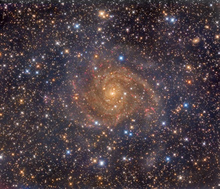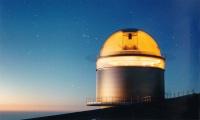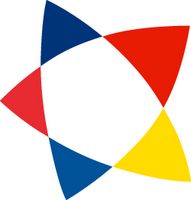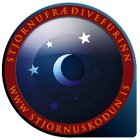October 21:
More new CAC arrivals, Kasper Elm Heintz officially started
his PhD studies at the beginning of the month. He'll spend
approximately the first half of his studies at DARK (working
with Johan Fynbo) while visiting Iceland frequently during
that period. During his first visit he told us about his M.Sc.
studies, among other things,
determining the fraction of reddened quasars in the COSMOS
field.

June 27:
At the beginning of the month we were fortunate enough to have
Jesús Zavala Franco joining CAC as an Assistant Professor. He's
originally from Mexico and has spent the last 3 years at DARK/NBI
as a Marie Curie Fellow. His main research interests are related broadly
to two topics, the intrinsic nature of dark matter, and its impact on
the formation, evolution and properties of galaxies. Although his
national football team has not
experienced great success this month, he can still share
our rather unexpected joy
in the Euro 2016. Celebrated via the approriate cake of course:
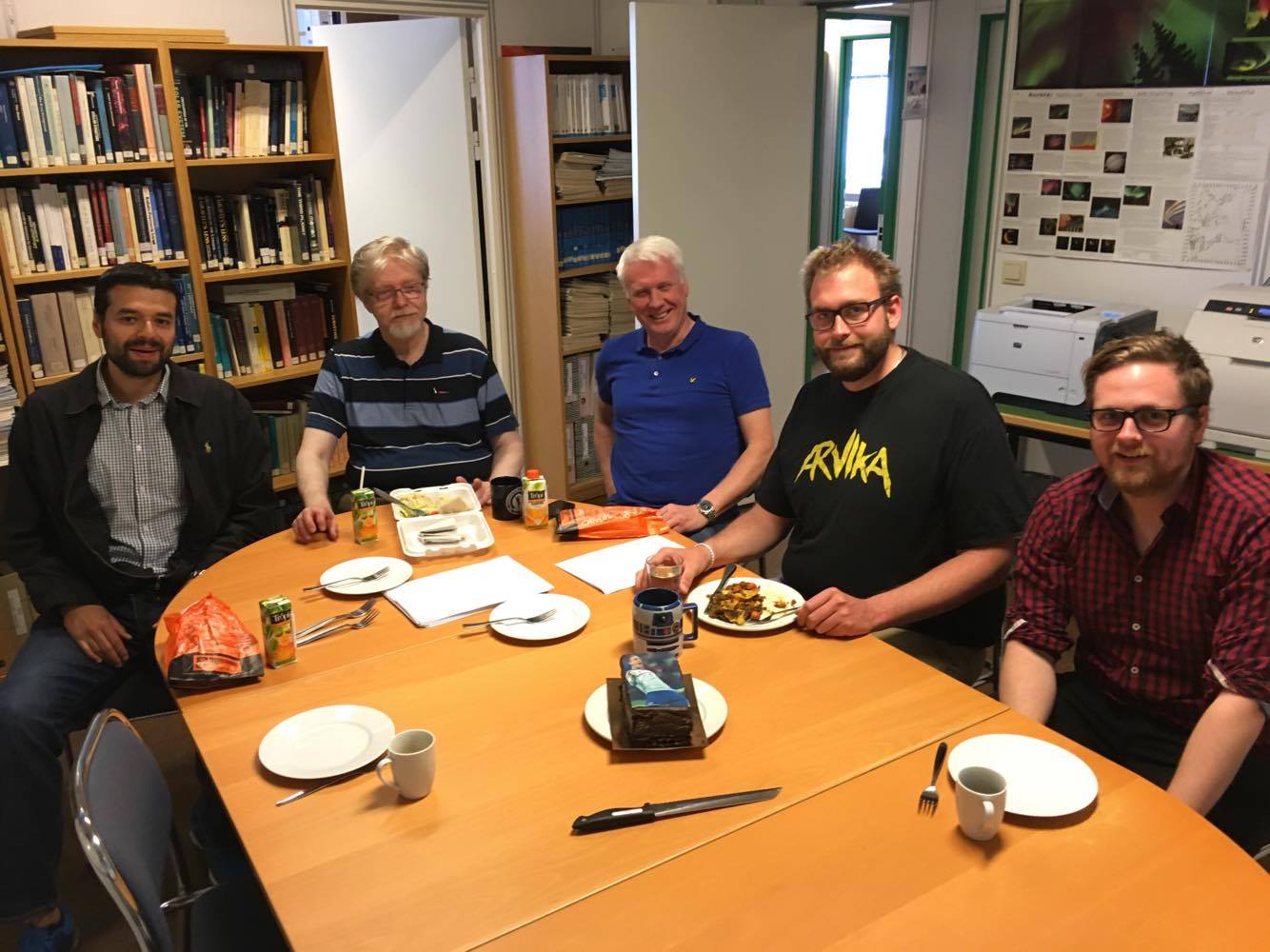
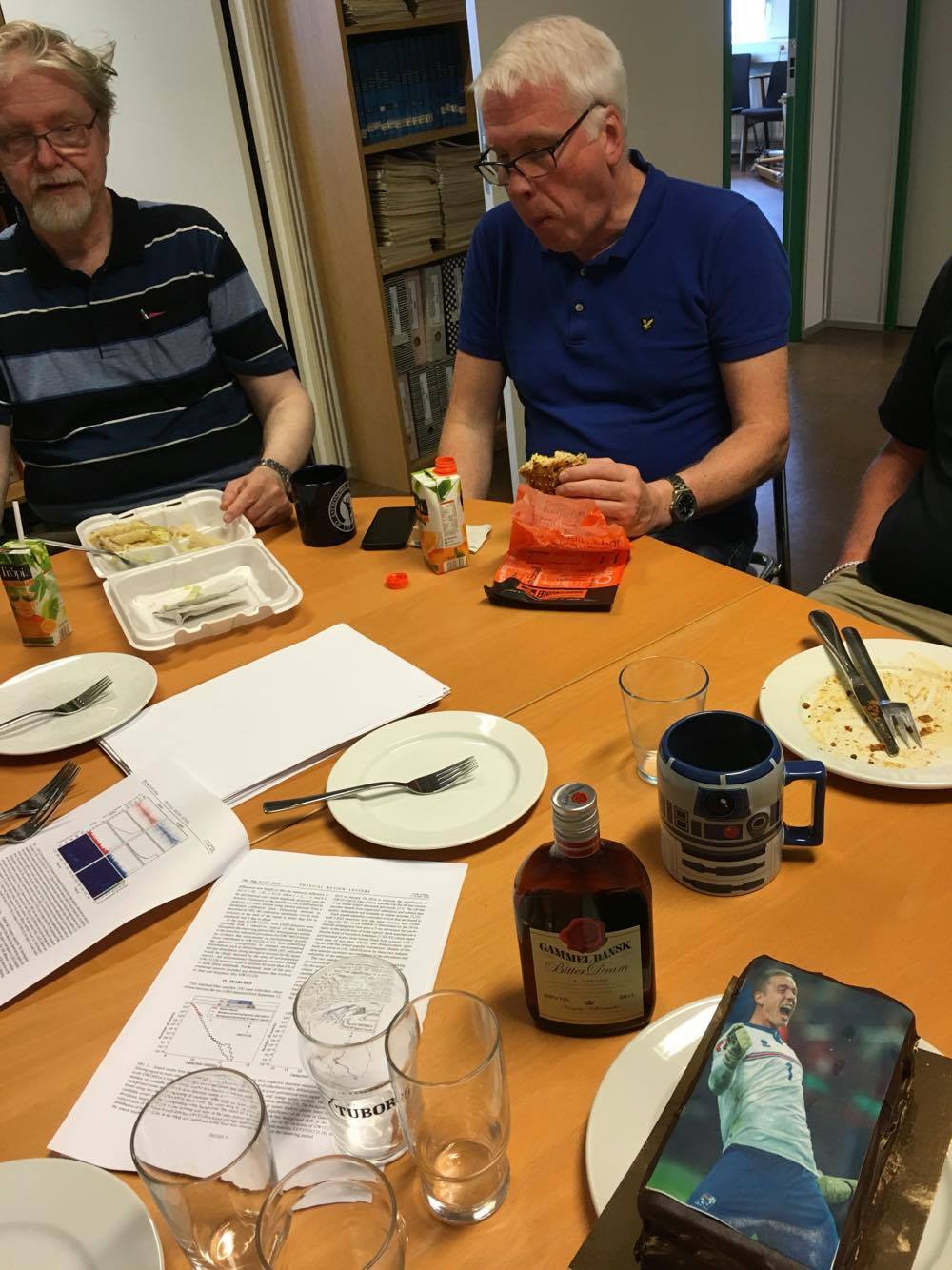
June 13:
Dr. Alex Nielsen at the Max Planck Institute for Gravitational Physics
dropped by on his way to the US and entertained us with a talk titled
Gravitational Waves with Advanced LIGO. Abstract: "On September
14th 2015 the merger of a binary black hole system was observed by the
advanced LIGO gravitational wave detectors for the first time. This was
the first binary black hole system ever detected by any means and a
milestone in gravitational physics. I will present an overview of the
detection, the science of gravitational wave astronomy, what we can learn
from the detection in terms of astrophysics and fundamental physics and
what the future may hold for this new field in astronomy."
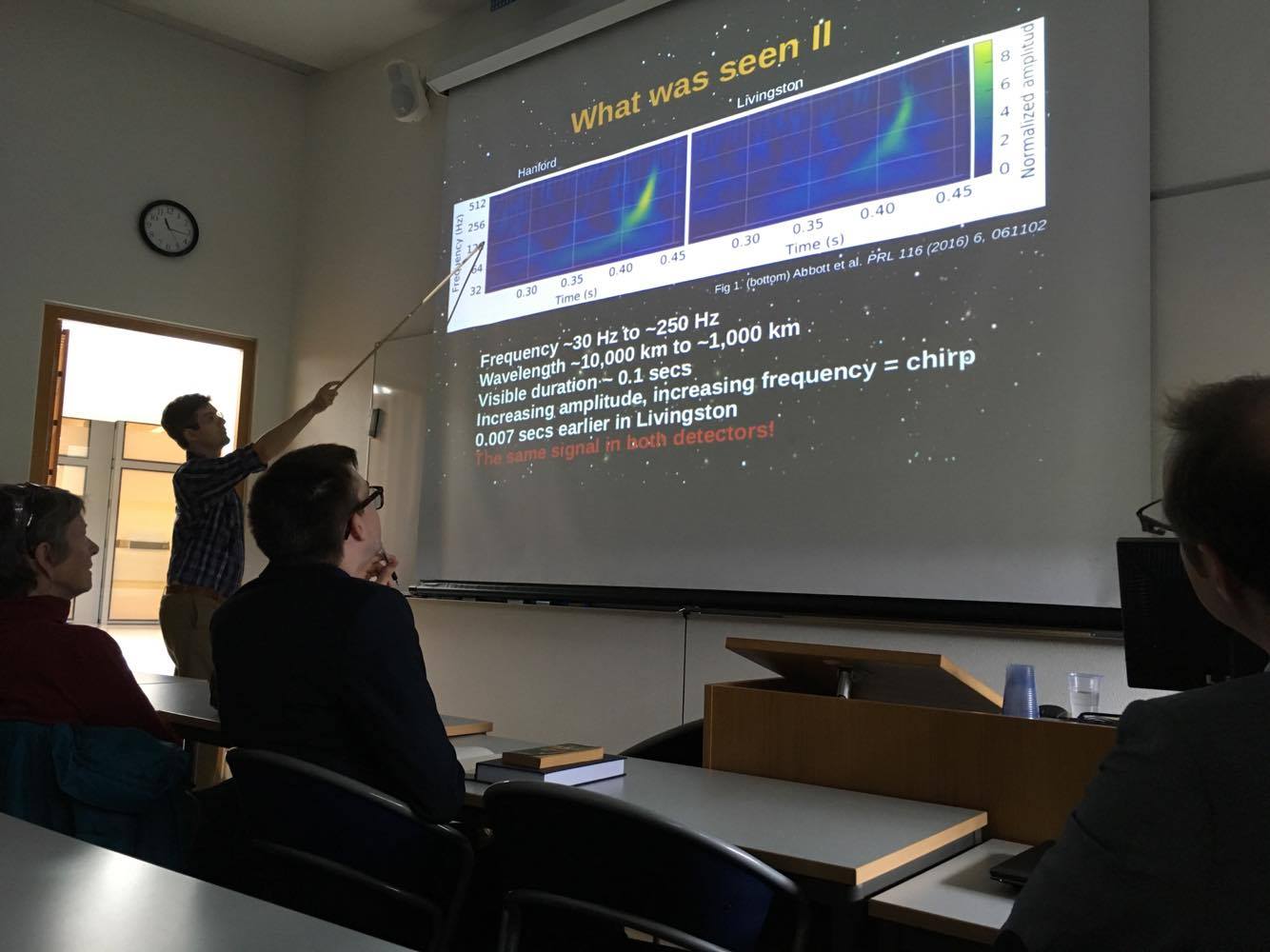
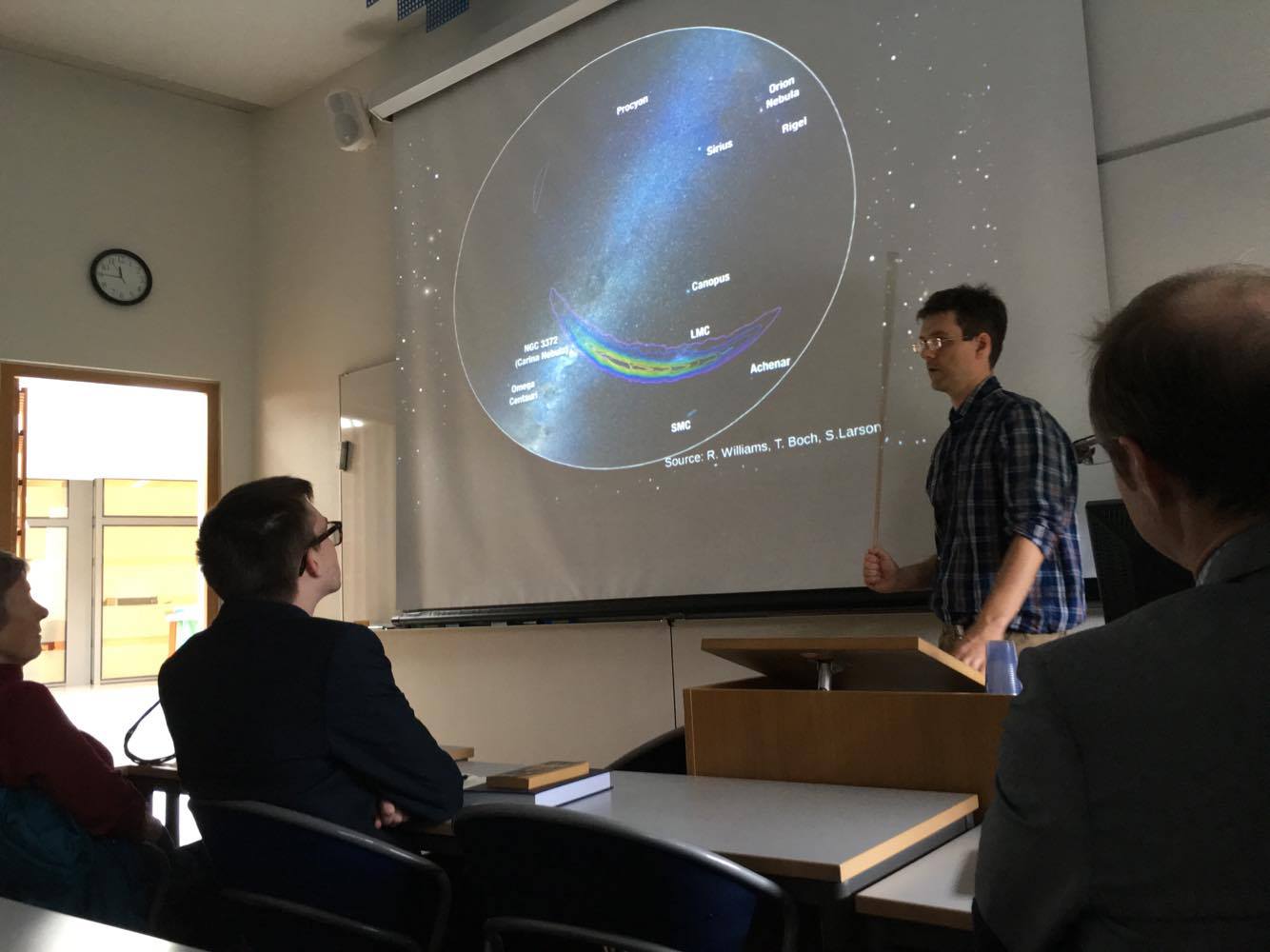
January 29:
For the last few weeks, Gabi Hodosán, a PhD student at the
University of St Andrews in Scotland, has been visiting us. She's
part of the LEAP project and
her studies focus on exploring lightning
characteristics on exoplanets and brown dwarfs. Recently she's been
working on statistical analysis of lightning spatial distribution and how
examples from the Solar System (Earth, Jupiter, Saturn,
Venus) can be applied to extrasolar objects. During her stay in
Iceland she obtained flash rates for certain volcano eruptions, such as
the 2010 Eyjafjallajökull eruption. These rates might be relevant in terms
of lightning studies on exoplanets and brown dwarfs. Press
release.
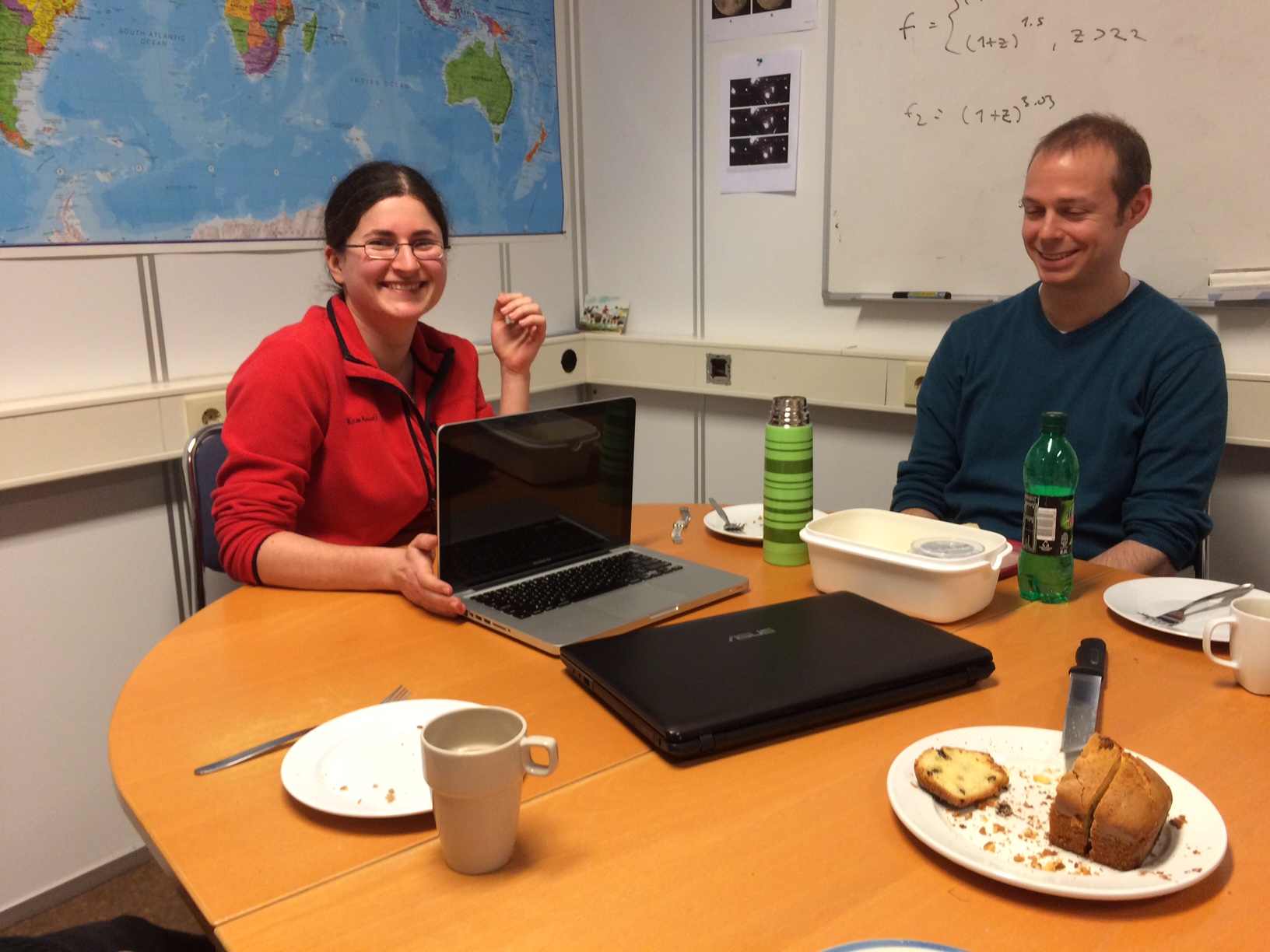
December 15:
Today Dr. Mette left CAC and will in early January join the
PoGOLite
group at the KTH Royal Institute of Technology in Stockholm.
We wish her the best of luck with her new balloon (experiment)!
And here is her CAC legacy: PhD thesis.
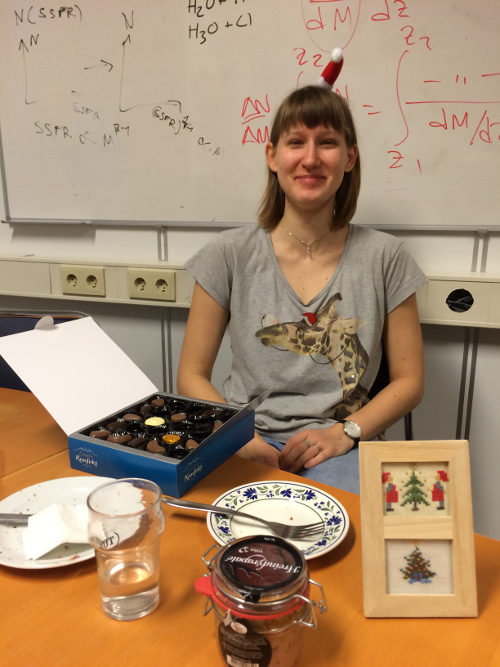
December 5:
Dr. Mette Friis! She passed with flying colours after a healthy
discussion with her opponents, Stefano Covino and Sandra Savaglio,
an interesting combination of North and South Italy. Needless to
say, everybody at CAC is more than a little bit proud of our new Dr.

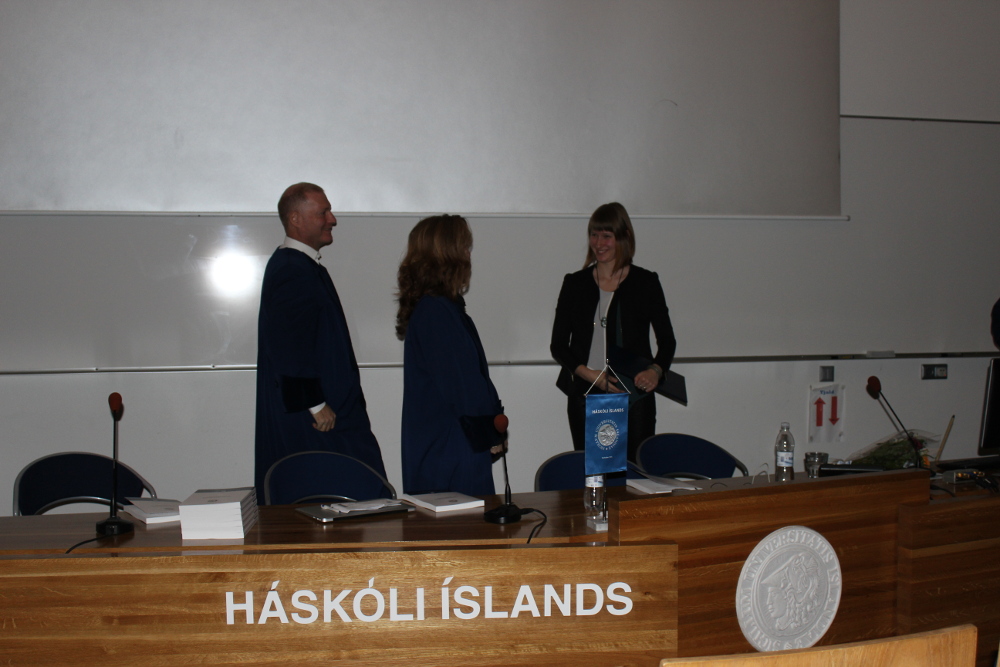

November 26:
With some of the members of CAC (version 2) leaving/graduating soon and
new ones arriving in 2016, somebody suggested a group photo. Unfortunately
without a cake. Nevertheless, a bunch of extremely handsome nerds.
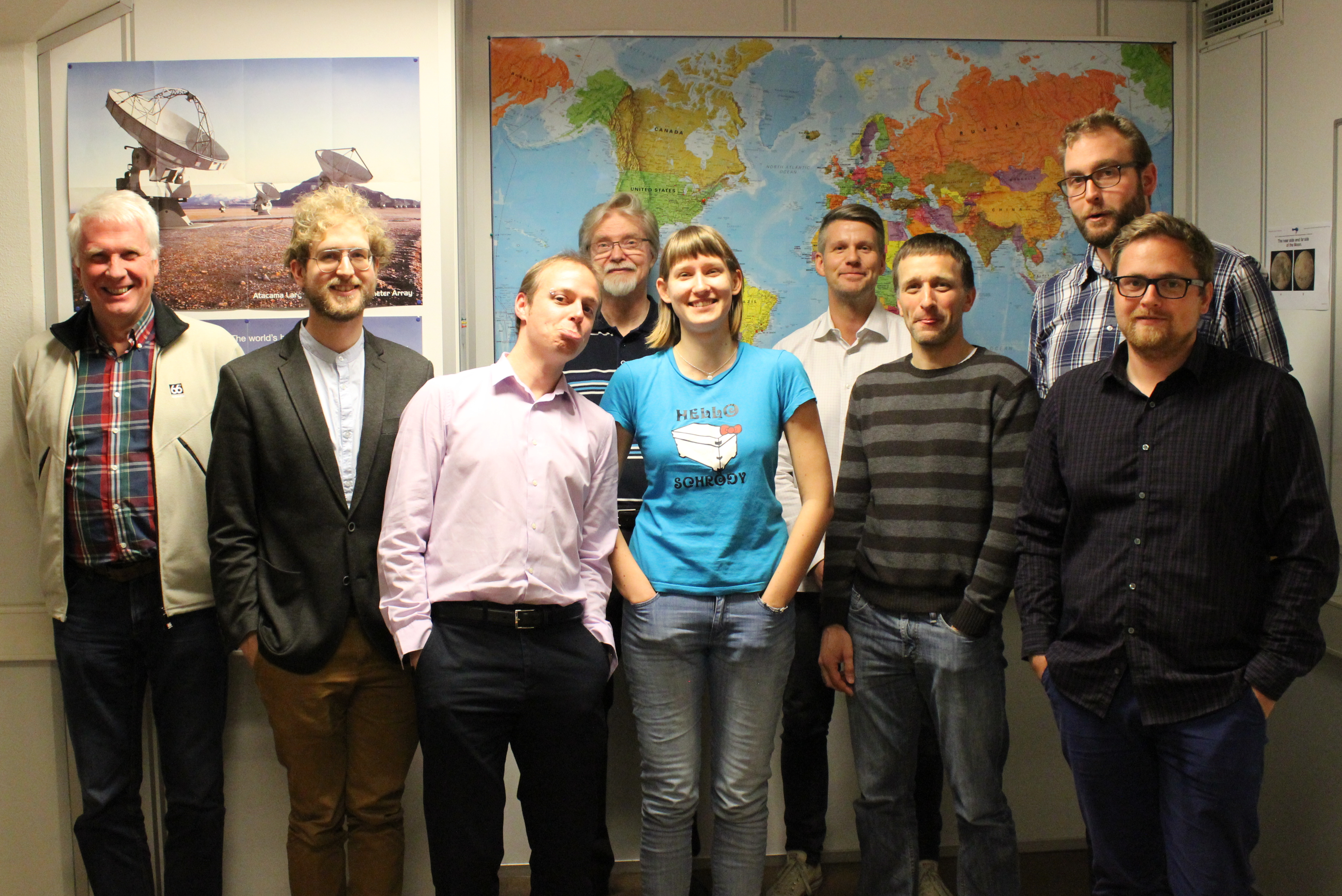
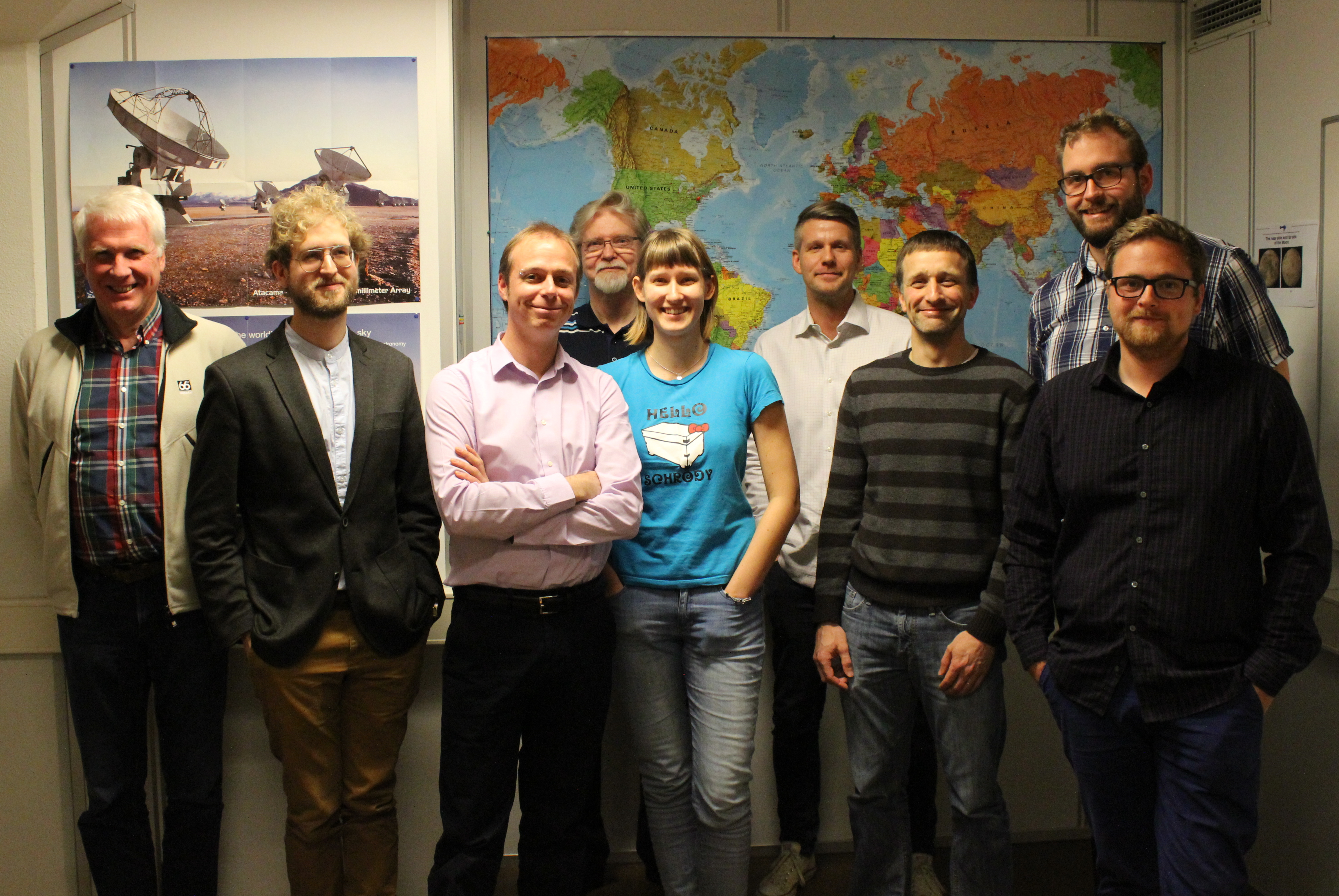
September 22:
Congrats to Guðjón
who not only has elements of Happy Gilmore to
his golf game, but can now use his brand-new M.Sc.
degree in astrophysics to enhance his golf swing and putts.
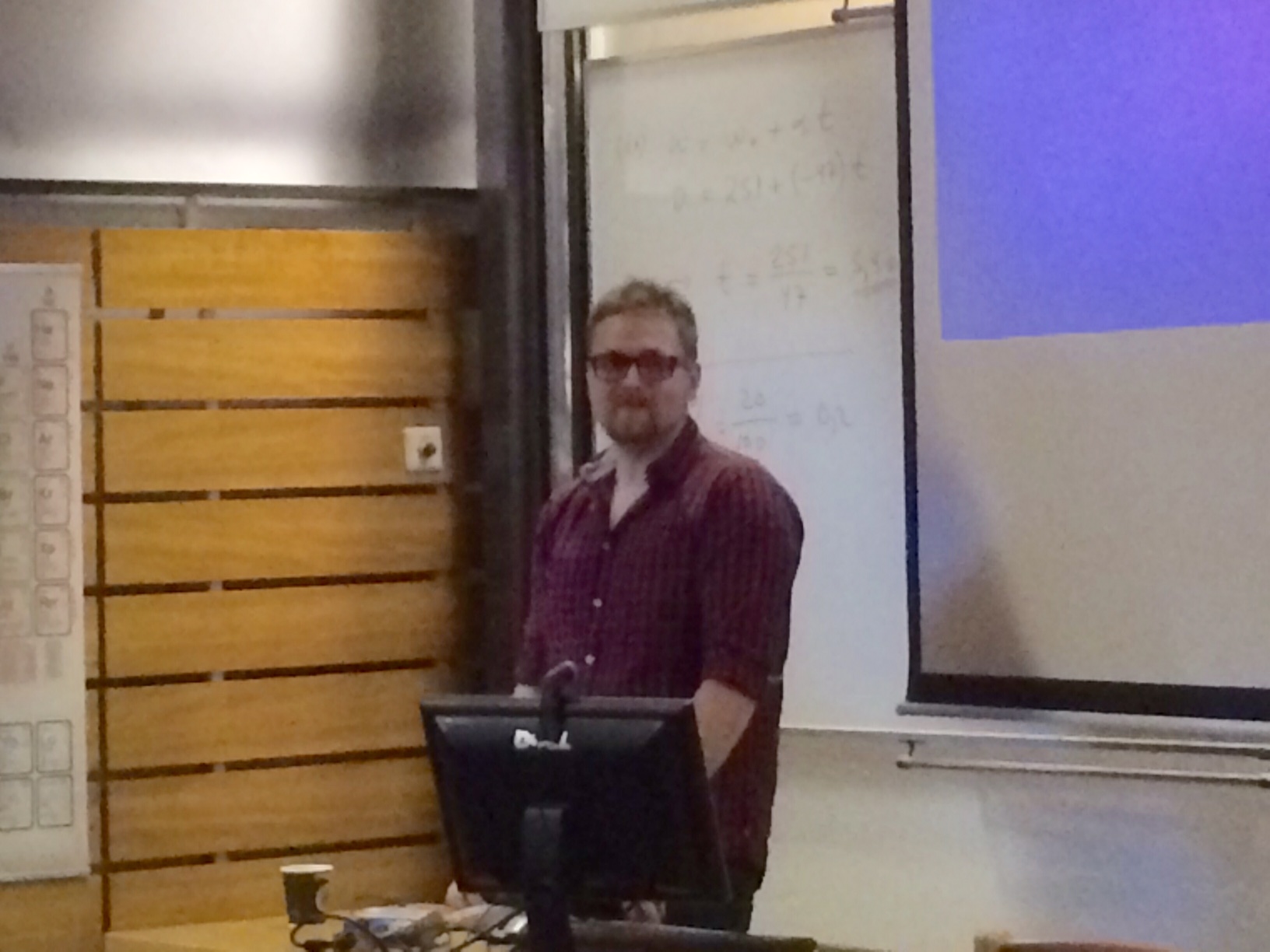


September 11:
Our office 318 has turned into a proper proxy for Scandinavia with Magnus Fagernes Ivarsen joining us from Norway until Christmas. He finished his undergrad studies at the University of Iceland but is currently working on his M.Sc. thesis with Per Lilje: Redshift space distortions as a test of modified gravity theories.
June 15:
Rachel Thorp, an undergrad from Caltech, will be visiting us for the next 8 weeks via the Caltech/University of Iceland Summer Undergraduate Research Exchange Program. Her work will be focused on fast radio bursts (FRBs) which are millisecond duration radio transients. More specifically, she will analyze data from the Fermi Large Area Telescope, looking for gamma-ray counterparts. Spoiler alert: no afterglows have been deteced so far, indicating this will probably result in non-detections. This can, however, still put constraints on the overabundance of theoretical FRB models suggested in the literature.
January 30:
Jóhann Pétursson, a.k.a. Johan Fynbo or Jóhann taðskegglingur,
dropped by for a visit this week. The main reason was finishing his work
in the UI selection committee for the new astrophysics faculty job. He
also gave a nice informal presentation about his GRB afterglow X-shooter
sample and enjoyed the most massive chocolate cake CAC has even seen (thanks
to Guðjón....or his brother).


November 28:
It has now become a Christmas tradition: Andreas and his merry
band of gifted musicians entertained everybody in Tæknigarður
with more than a few festive Christmas songs. Well done!
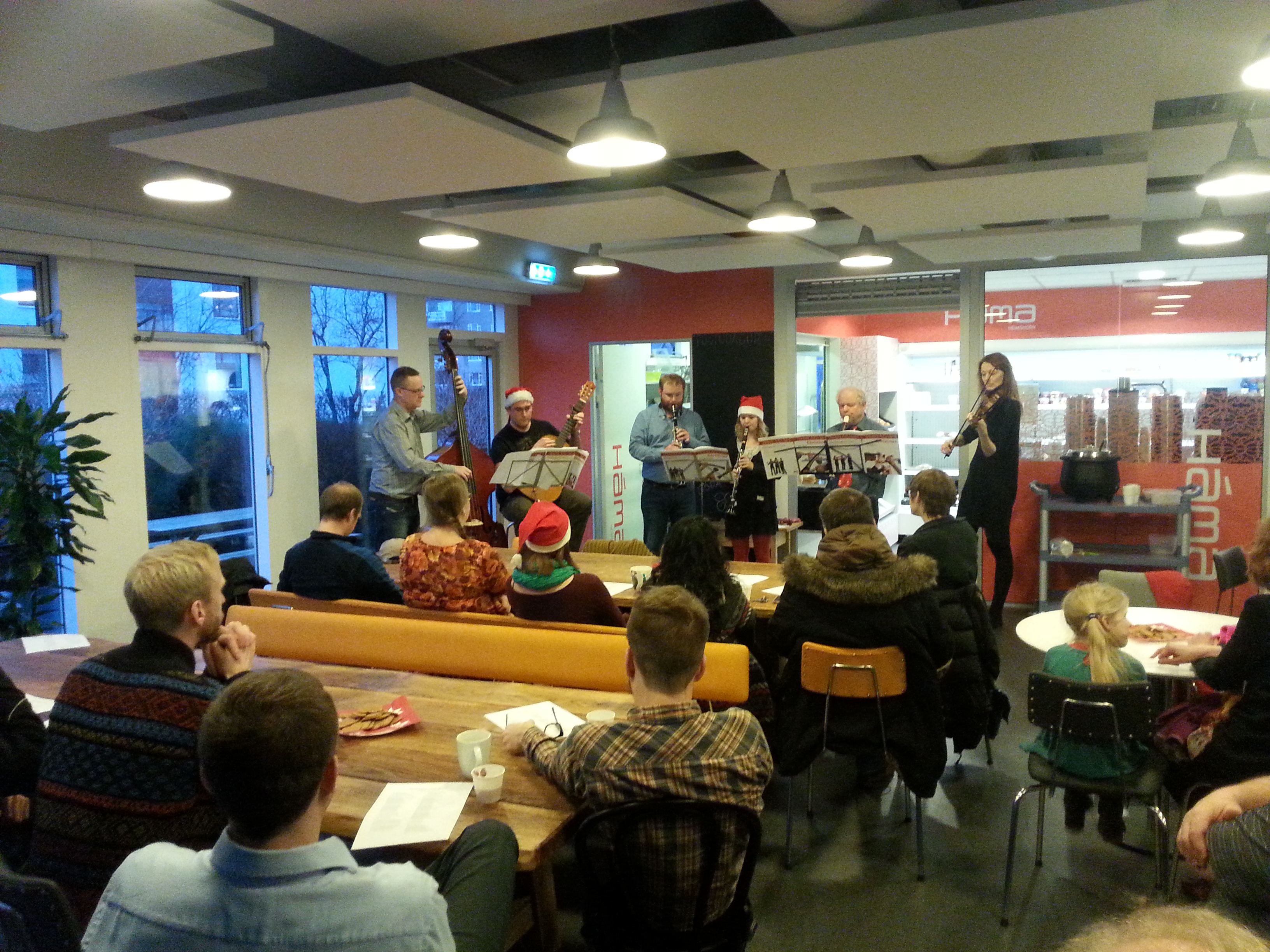

November 21:
Andreas just finished his "halfway done with my PhD" presentation.
And to celebrate he and his girlfriend baked delicious saffron buns
(lussebuller in
Swedish) and brewed some outstanding IKEA julglögg. Only 18 months
to go....


September 5:
Dr. Rebekah Hounsell, originally from the UK, has been visiting CAC for the last month. She studied novae at Liverpool John Moores University during her PhD. However, within her postdoc she has now moved on to the study of GRBs, SNe and tidal disruption events (TDEs) at the Space Telescope Science Institute, Baltimore, USA. She gave a talk discussing her current work on the suspected TDE SW J1644+57, and how precise astrometry may constrain the true nature of the progenitor. Within the talk she described a new technique that she and her colleagues at STScI have developed to align HST epochs using background galaxies as astrometric markers. This technique involves the cross correlation of galaxy regions in different epochs, enabling the determination of an astrometric solution and avoids errors introduced by proper motion when using stars. This technique has enabled the STScI group to determination of a much smaller relative offset between the host and transient, as well as to significantly reduce the positional errors previously obtained.
August 29:
One of our "old" students, Helgi Freyr Rúnarsson, is visiting
for a couple of weeks. He's now a Ph.D. student in Portugal and
honoured us with a chat about his latest paper on Kerr black holes.
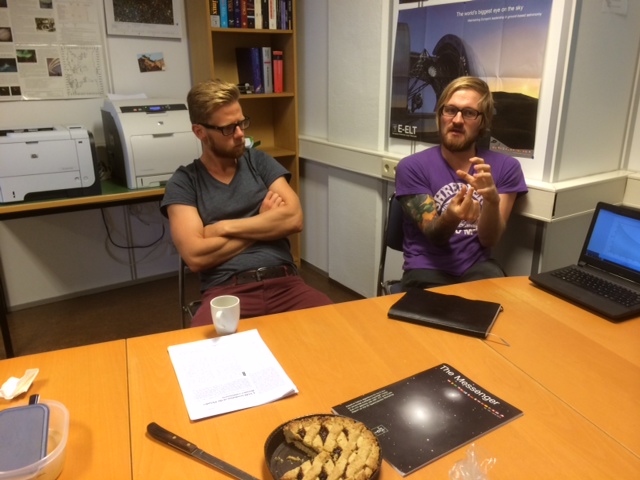

August 20:
Nir Shaviv, an
Israeli‐American physics professor dropped by on his way to Princeton
for a sabbatical. During lunch he gave us a laid-back talk on
"Predicting Supernova Precursor Outbursts". He also gave a public talk on
climate science titled "Cosmic Rays, Solar Forcing and 20th Century
Climate Change" which abstract was:
The 20th Century has seen a notable temperature rise, generally
attributed to the greenhouse effect of anthropogenic gases, and a
future "business as usual" policy is generally believed to be
catastrophic. However, significant evidence indicates that the sun
plays a major role in climate change. We will review the evidence
which proves the existence and quantifies the physical mechanism
linking between solar activity and climate—galactic cosmic ray
ionization of the atmosphere and its effect on cloud cover. We will
also discuss the experiment carried out to pinpoint the exact
mechanism. We will see that once the link is taken into account, a
much more consistent picture for the 20th century global warming is
obtained. In it, climate sensitivity is low and future climate change
is benign.
May 9:
For the last week, two of the original CACers have been visiting
to work on The Neverending Story (TOUGH 7: GRB Host Luminosity
Function). It was great having them back, in their honour Mette
even baked a cake consisting of 110% Baileys. And then we went
for dinner at the Seafood Grill
(Sjávargrillið). Needless to say, one menu item saved the
night for Steve: European Shag. The Icelandic translation is
much more boring (skarfur).

April 11:
Louise Edstam from Uppsala University (recently finished her
B.Sc. in astronomy) dropped by and talked about her thesis
work: Ranking line-depth ratios for determining relative star
temperatures in dwarfs. During the discussion we managed
to devour Cake of the Year
2014. Yummie.
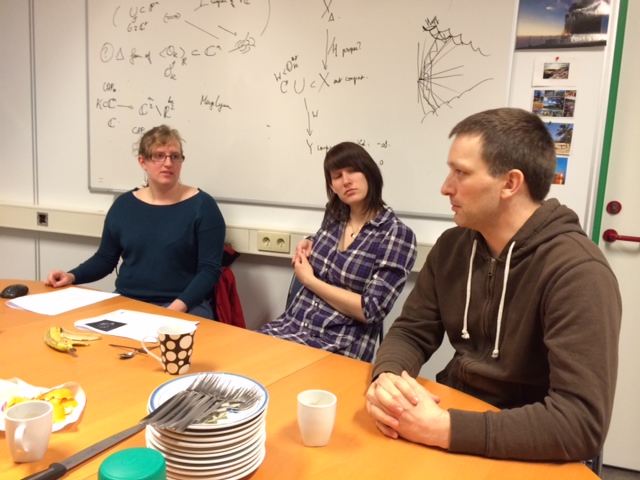
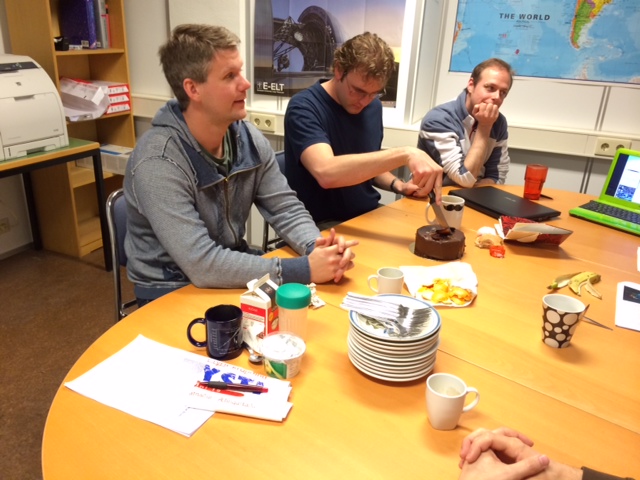
March 28:
Kári
Helgason, a PhD student from the University of Maryland
(but soon to move to Max Planck in Germany), dropped by
and told us a bit about his project. What are the sources
behind the unresolved infrared background? Who knows, maybe
there are some clues in his two excellent papers from
2012
and
2014.
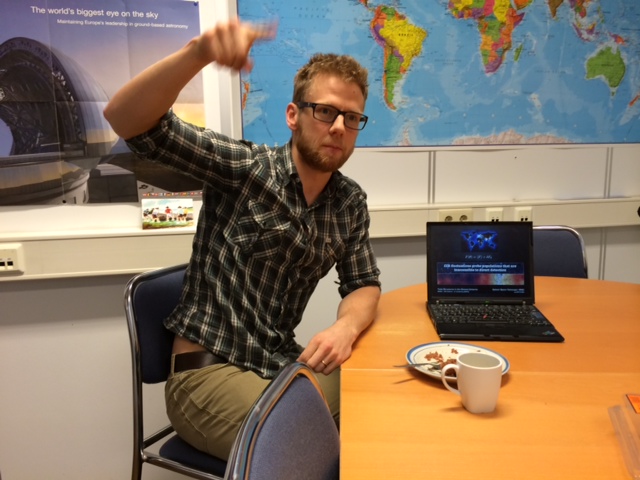

March 7:
Today we had to buy roughly 100 beers (among them the superb
Jesús)
and order 15 large pizzas. Not bad for a Friday afternoon.
The reason? Stigull (= gradient), the student society
for maths and physics, paid CAC a visit. The price they
paid for devouring the delicatessen described above was
listening to us ramble on about astrophysics. I think
it went quite well, a good part of the group didn't
leave until all the beers were finished, resulting in
some very lively discussion.....
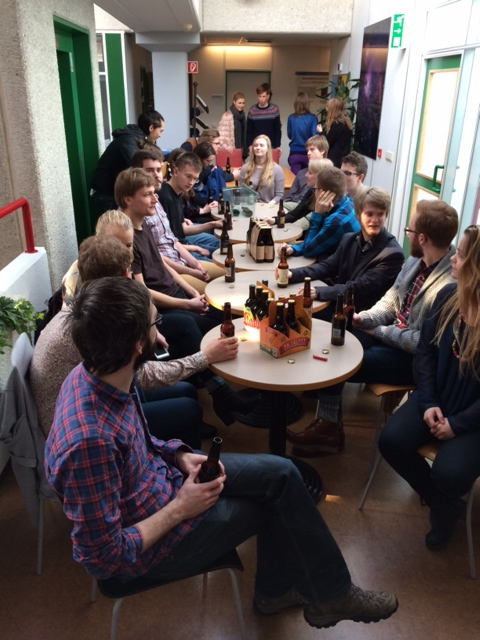
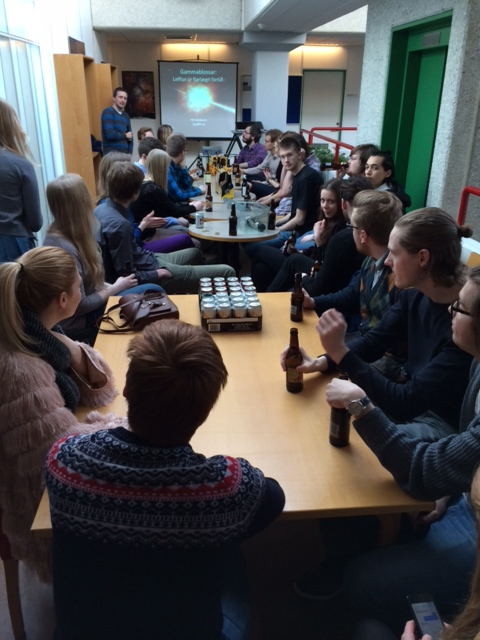
Jan 30:
Happy new year! For the last couple of months, Jón Emil Guðmundsson,
a grad student from Princeton, has been visiting. His PhD thesis
(to be finished this year) focuses on
Spider,
a balloon-borne experiment designed to search for primordial
gravity waves imprinted on the cosmic microwave background. Measuring
the strength of this signal puts limits on inflationary theory.
As can be seen below, his WMAP cap (knitted by his girlfriend) caught
a lot of attention along with the G&T cake he baked.
In other news, Zach got his second CAC first-author
paper
accepted, this time on Type Ib SNe. He has already paid the price
by buying us a cake.
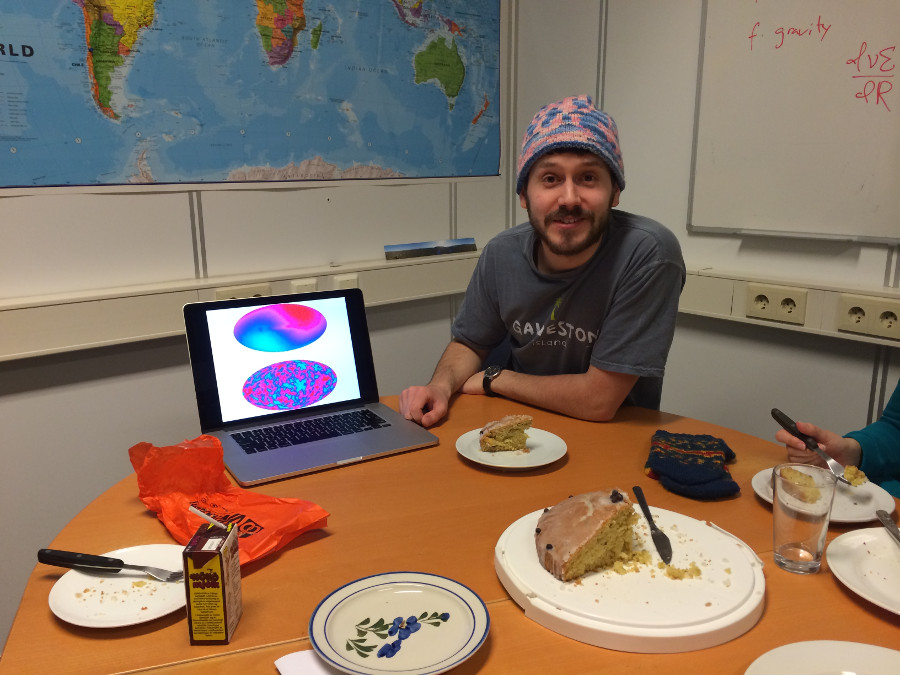
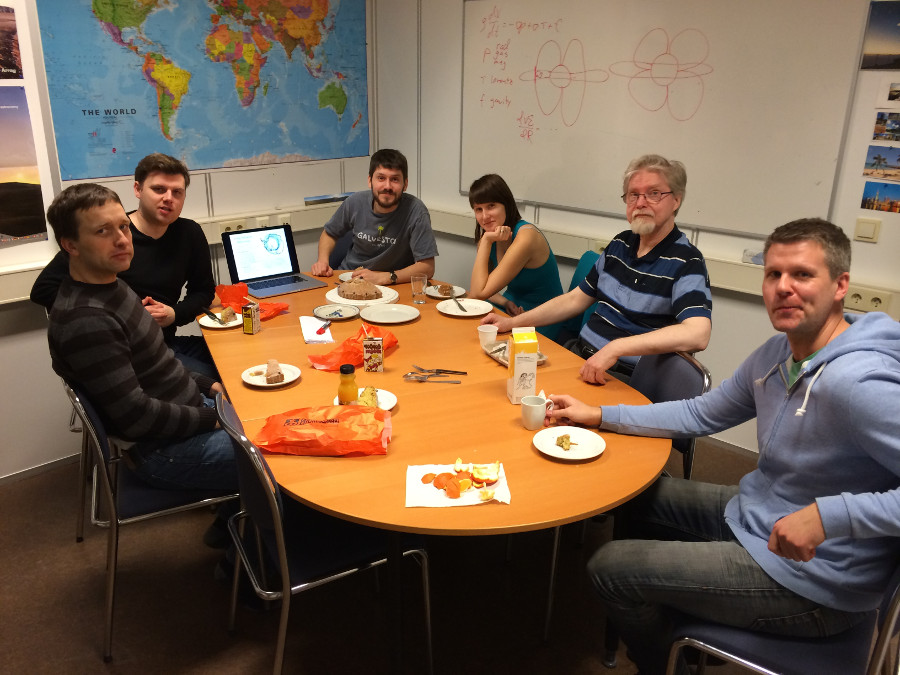
July 8:
And we finally have some pictures of our CAC group (version 2) having
our cake and eating it too!

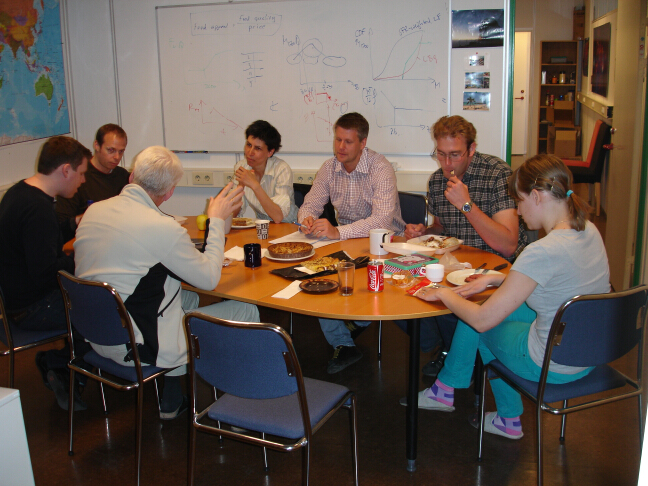
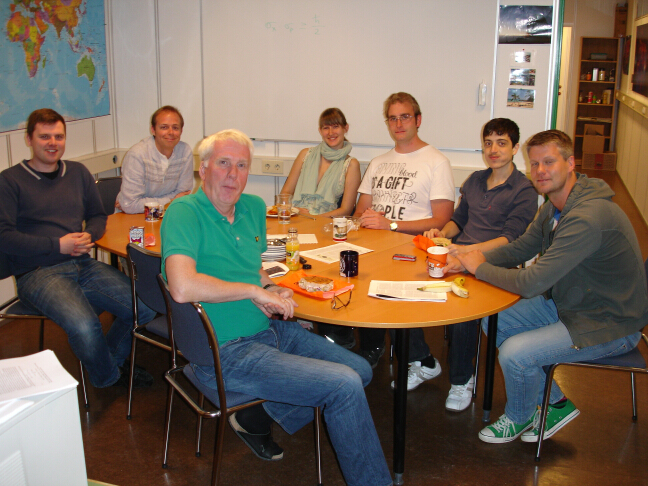
June 24:
David Vartanyan, an undergrad from Caltech, will be visiting us for the next 8 weeks working on, among other things, flares in XRT light curves and their implications for the progenitors of GRBs. He's here via the Caltech-University of Iceland Summer Undergraduate Research Exchange Program. He will eat his first CAC cake on Friday (see item below).
June 10:
Zach's first first-author CAC paper has been accepted. Not only is he the first author, but more impressively, the sole author. He now owes us a prizewinning, stellar cake, par excellence. Did we mention that this cracking cake also has to be dandy, peachy and unsurpassed?
May 20:
CAC's been a busy place recently, so no time to update these webpages.
But here goes. Mette has had her first paper accepted for ApJ: Thermal Emission in the Early
X-ray Afterglows of GRBs: Following the Prompt Phase to the Late Times.
This resulted in some serious cake-baking: G&T cup cakes that even outdid
her White Russian cup cakes. Happy times. During this process a new CAC
cake rule was accepted: whenever an accepted paper receives its first
citation --> bake a cake.
Over the past month some good old friends have also visited:
Steve and Bob working on TOUGH 7 (Host LF) and Stephanie continuing
digging for GRB hosts in her neat and impressive simulations. A few
interesting stories were reminisced about in Steikhúsið and new gossips told at
the fantastic
Micro Bar. Some pictures to follow soon....
Jan 7:
And we have another PhD student just arriving, Andreas Johansson from University of Gothenburg. He's a bit more theoretically minded than Mette (who's now reducing X-shooter spectra like her life depended on it) and we'll be expecting him to hand in his thesis just after Mette, or before midnight on 7 Jan 2016, not a second later!
Dec 6:
Our old friend and postdoc, Stephanie Courty, will be visiting for a month. Apart from enjoying Christmas in Iceland, she'll be discussing how to connect her simulations to GRB host galaxies.
Nov 19:
We have a new postdoc, Zach Cano, who will continue working on GRB-SNe along with adding X-shooter reductions/analysis to his scientific arsenal. Zach is an American with a UK citizenship. In fact, he got his PhD from Liverpool John Moores University, not a bad city to live in!
Oct 1:
Mette Friis just arrived from DARK with a brand-new M.Sc. degree. Let's hope she leaves Iceland with a proper Ph.D. degree in around 3 years!
June 12:
Kjartan will defend his M.Sc. thesis today. The topic is Gravitational Lensing Statistics.
June 7:
Palli receives the Motivation
Award for Young Scientists for 2012 from the Science and
Technology Policy Council. And a couple of links in Icelandic here
and here and
here.
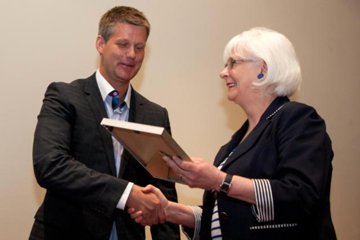
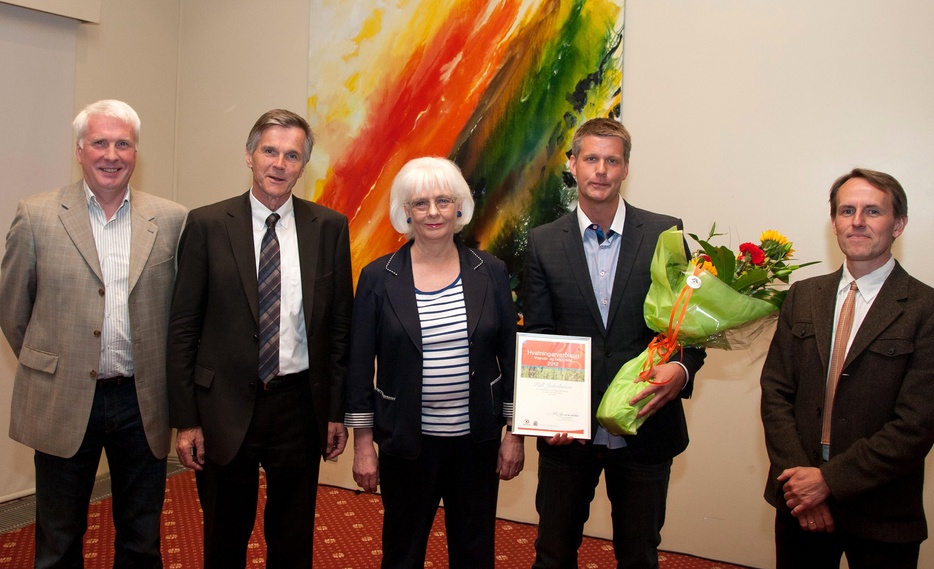
May 10:
And we finally have pictures from Steve's big day.
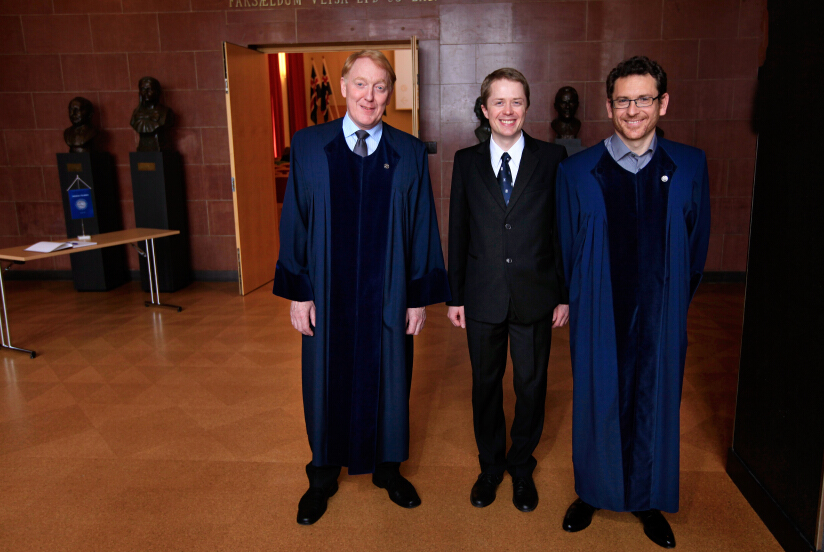
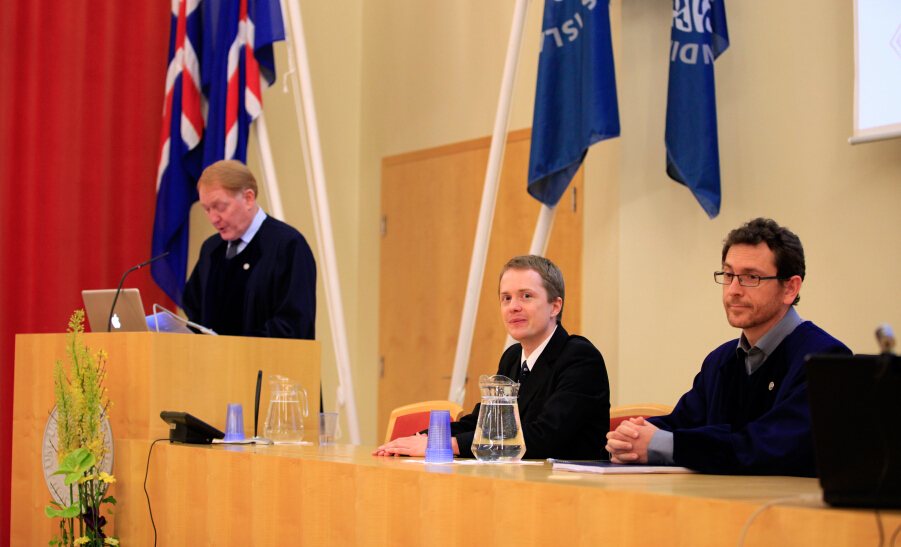
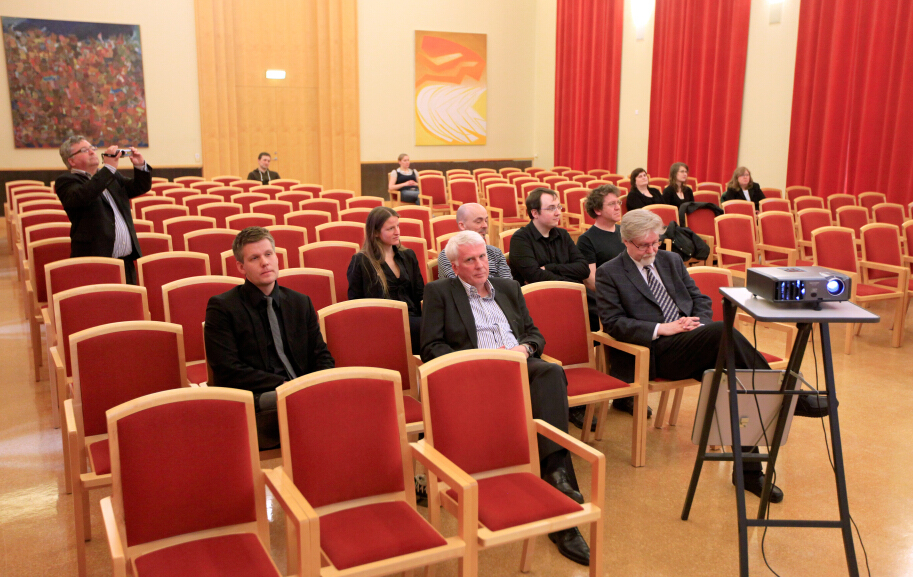

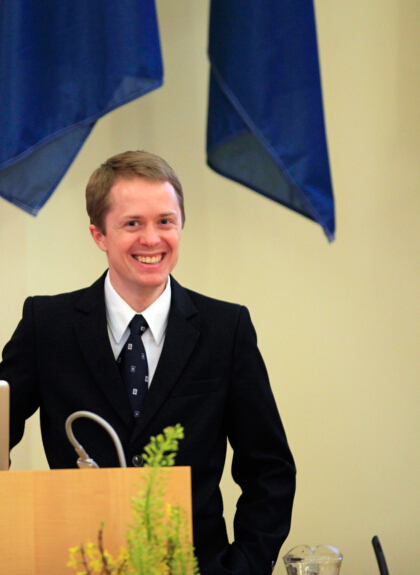
April 4:
Herr Steve is now Dr. Steve! Well done. One of the opponents, Stefano Covino, had to appear via Skype during the defense. Thanks to our technological supernerd, Bob, this went fairly smoothly. The other opponent, Javier Gorosabel, behaved impeccably during his stay.
December 16:
Herr Steve just submitted another one of his papers. As is the CAC
tradition he was ordered to bake/buy a cake and some nice wine
to go with it. Annalisa is next!

July 1:
Dr. Annalisa! Needless to say, she excelled during her Ph.D. defense.
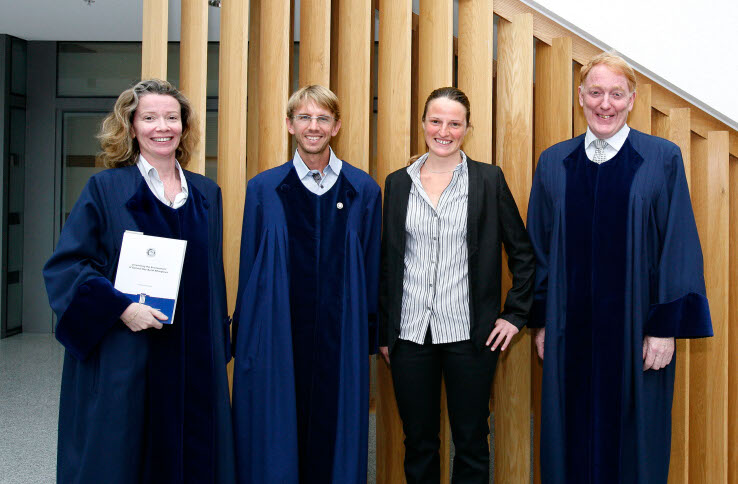
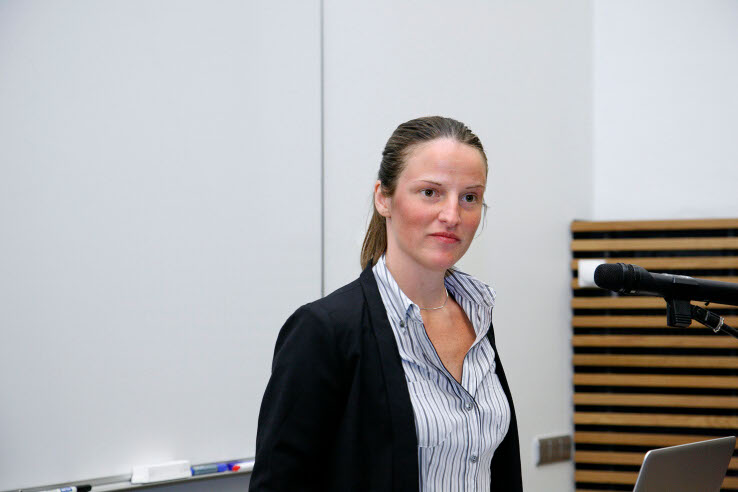


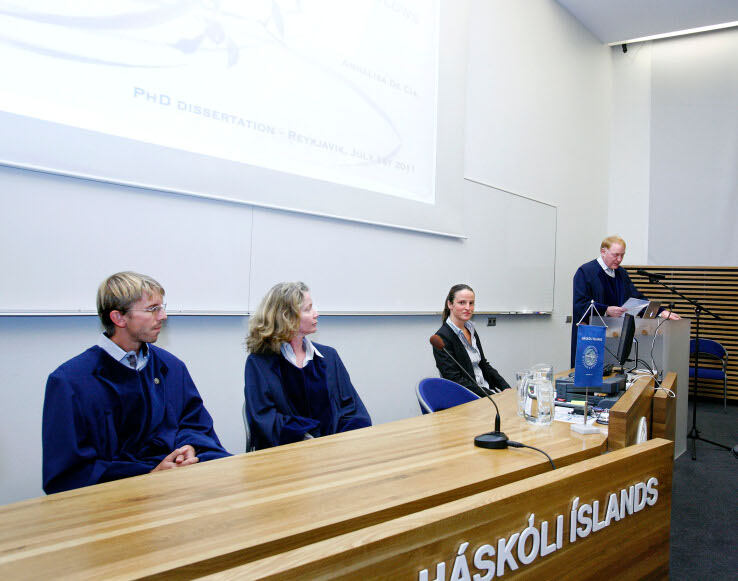
June 10:
Kris Sigurdson from The University of British Columbia briefly visits CAC (on his way to Árdís's wedding).
May 20:
Today is quite a big day for Annalisa: (1) The school has decided that spring cleaning will be held from 10-15. As the only woman in the group, she has volunteered to clean the CAC offices. (2) She has to hand in her PhD thesis. We are pretty sure that both events will be celebrated with some kind of liquid.
May 19:
Kári Helgason, a graduate student from the University of Maryland, is visiting CAC for approximately a month.
April 29 - May 16:
Our "old" postdoc Stéphanie Courty from Observatoire de Lyon is visiting CAC.
Here she is telling us all about modelling streams through galaxies:

At the same time it was Paul's birthday. He (or probably Annalisa) baked
a delicious cake for us and Annalisa spent 483 minutes whipping cream
with a fork. Even Bob showed up in his royal suit:


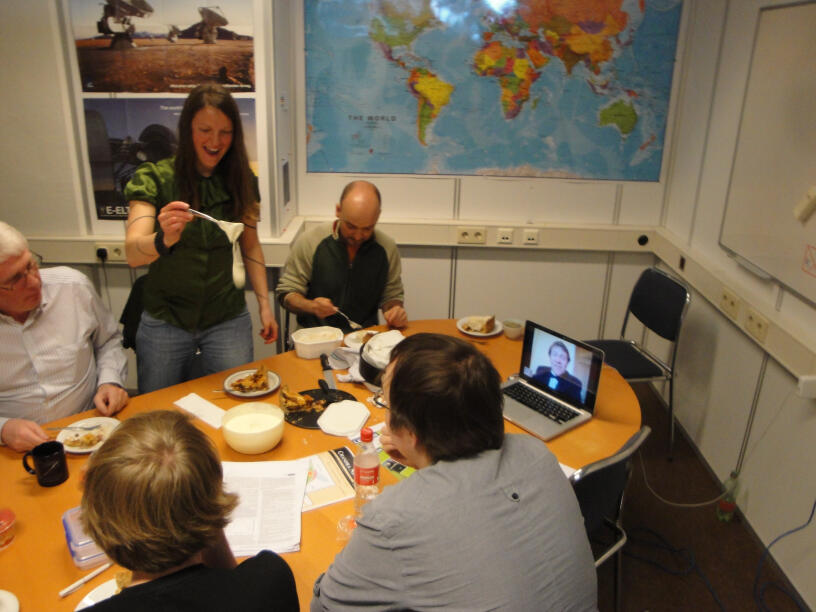
April 7:
A class from Sønderborg Statsskole (age 17-19) visits CAC. To welcome
them, Bob, Steve, Sævar and Gulli organized short talks for them about
GRBs, aurora borealis and astro PR stuff in Iceland. The teachers were
kind enough to reward us with the typical (and superb) Danish gift of
a bottle of snaps. It was quickly finished:

Feb 27 - March 14:
Árdís Elíasdóttir from DARK visits CAC.
Nov 23-25:
Our ASH
Nordic workshop/meeting went very smoothly. Just look at
the "conference" picture (too many grinning nerds warning):

Nov 19:
And now the CAC PhD student score is even (1-1); Annalisa's first paper has just been accepted for MNRAS: Probing GRB environments with time variability: ULTRASPEC fast imaging of GRB 080210. We look forward to see/taste the beer Steve is now obliged to buy for Annalisa. Surely he will buy some kind of jólabjór....
Nov 9:
Thanks to Annalisa's superb feminine design qualities and Steve's
macho graphical programming skills, our centre finally has a stunning
and exquisite logo:
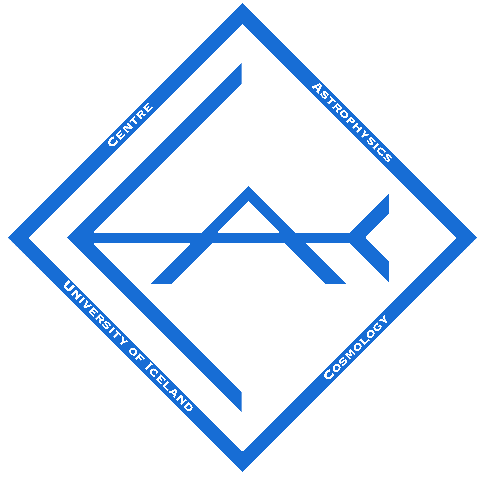
Nov 1-4:
The dashing duo (Palli & Steve) travel to Annapolis for the Gamma Ray Bursts 2010 conference. While the former blabbers on about Host Galaxies of Long Gamma-Ray Bursts, Steve tackles endless questions about his poster (on his recently accepted paper). No groundbreaking GRB news from this conference; we need something interesting to happen soon to spice the field up....
Oct 21:
Steve's first paper has just been accepted: The Circumburst Density Profile around GRB Progenitors: A Statistical Study. This is bad news for Annalisa who now has to buy Steve a delicious tasting beer. More news on this bet will be announced soon.
Oct 19-22:
The dynamic duo (Palli & Paul) travel to Como for the The First Year of Science with X-shooter conference. One gives a review on GRB-Selected Galaxies and both enjoy the company of a certain Maximilian Stritzinger. What can you say about Max and his "evicted from his hotel room" antics. Classic stuff.
Oct 15:
Steve just finished his "halfway through his PhD" exam by giving a 45 min talk reporting on his research. Just 18 more months to go...
Oct 5:
Gulli Junior will give a public talk this evening about his research with the Fermi satellite; it's in Icelandic.
Sept 3:
Thanks to Annalisa, our weekly Friday astro-ph meetings have been resurrected. Today we mainly discussed this monster and Bob promised, via his Skype videolink, to bring back some proper Champagne in order for us to make French 75. The occasion of course being Annalisa's submission of her first paper next week.
August 23:
Gulli Junior (a.k.a. Guðlaugur Jóhannesson) joins CAC for at least the next 3 years. He will also be affiliated with Stanford University and will spend 3 months every year there working with the Fermi team.
August 13:
Karl Joakim Rosdahl (Universite Claude Bernard), who has been visiting CAC for a month now, joins us for a trip to the bakery after which he tells us about his PhD project (halfway through it) titled Cosmological simulations of early galaxy formation. His informal talk focused on A numerical implementation and application of radiative transfer.
July 20:
Although only arriving 19 days too late for his first day at the
office, Paul was ecstatic finally reaching the Reykjavík harbour.
However, Annalisa looked a bit confused. Steve, on the other hand,
looked very comfortable at the "docking party".




July 16:
Jón Emil Guðmundsson (Princeton University) gives a "coffee meeting"
talk titled Precision Cosmology and the Search for B-modes.
Abstract: Developments in observational cosmology have converged on a
world view incorporating the big bang followed by nucleosynthesis,
structure formation and, relatively recently, an accelerated
expansion. It is safe to say that observational cosmology has
revolutionized our understanding of the Universe. Nevertheless, the
"standard cosmological model" provides no solution for the horizon and
flatness problems, no phenomenological description of structure
formation. While inflationary theories of the embryotic Universe
provide these missing links, the observational evidence to date is
purely circumstantial. We will describe prospects for detecting a
minute polarized inflationary signal in the cosmic microwave
background (CMB), a signal that has been called "the smoking gun for
inflation." We will present a few CMB experiments, some of which are
designed to reduce the upper limits of this signal amplitude. Finally,
we will focus on some instrumentation aspects for a balloon-borne CMB
experiment called Spider.
June 6 - 19:
Palli visits DARK in Copenhagen for a couple of weeks to finish a paper (or papers) based on the VLT Large Programme on host galaxies. Hopefully the World Cup won't disturb the science too much.
June 4:
For his LOC work last year, Bob was shortlisted by the Herts Vice-Chancellor for
"Engagement with international and European partners". Congrats! Even though he
didn't win it, his group was "highly commended" which is a nice way of putting it.

June 2:
Annalisa and Paul set sail for Iceland. They are leaving from Copenhagen, stopping in Norway, then heading towards the Shetland Islands, then the Faroe Islands. ETA in Iceland: end of June. Therefore we hope to have a new CAC postdoc on July 1. However, given Annalisa's map directions we might not see them until Christmas....
May 24 - 29:
Palli and Annalisa attend the Nordic Astrophysics 2010 conference in beautiful Visby (Gotland, Sweden). Apart from giving a couple of talks ("Is there a significant fraction of GRBs located in dusty environs?" and "The excited and ionized environment of GRB 080310"), Palli frequently beat Annalisa in running around the city wall of Visby. The reason probably involves her never actually waking up for the runs.
May 17 - 22:
Steve attends the International School Exploring the Dawn of the Universe with Gamma-Ray Bursts in Corsica. Rumor has it that Steve is quite enthusiastic asking questions, even more so than the other students combined!
April 16 - 26:
Palli attends Deciphering the Ancient Universe with Gamma-Ray Bursts in Kyoto and gives a talk on "Low-Resolution Spectroscopy of Gamma-ray Burst Optical Afterglows: Biases in the Swift Sample". He was almost stopped by the Eyjafjallajökull eruption and had to fly west to get east! Unfortunately, Annlisa was stopped by the evil thing.
March 20:
Palli and Gulli give a couple of public talks at the Wonders of the Universe meeting in Akureyri. This was part of the IYA2009 so apparently they use a different calendar up north! On the way back Palli's flight was delayed due to the recently started volcanic eruption between the glaciers on Fimmvörðuháls.
Feb 19:
Ingólfur Ágústsson (Boston University) gives a "coffee meeting" talk titled Probing Dark Matter Halos Using Satellite Galaxies. The abstract can be found here.
December 18:
Anna S. Árnadóttir (University of Lund) gives a give a talk titled A closer look at the Galactic thick and thin disks with Strömgren photometry
October 7 - 16:
Paul Vreeswijk from DARK visits. He'll give us some overview of basic X-shooter data reductions in addition to working with Annalisa on finishing the GRB 080310 paper (excited Fe III variability).
May 25 - June 1:
Stephanie Courty visits. Main purpose is to tell us what she's been doing in Preston wrt to GRB host modelling and reminisce the good old days (she was a postdoc here for 3 years).
May 22 - June 19:
Johan Fynbo (a.k.a. Jóhann Pétursson) from DARK will visit for a month. Purpose of visit: write papers, write papers and write papers.
April 20 - 23:
Bob is in the Local Organising Committee for the European Week of Astronomy & Space Science which incorporates both the 2009 NAM and 2009 JENAM at the University of Hertfordshire.
April 17 - 24:
Andrea Rossi visits from Thüringer Landessternwarte, Tautenburg.
March 16:
Robert Chapman arrives from the UK on a self-proclaimed Thor Fellowhip. He'll spend around half the time in Iceland, the other half in the UK. His first impression of the country is that there is too little and too fluent bureaucracy in place here.
Feb 16:
Welcome to PhD student Steve Schulze. He will begin full-time work at CAC this week and will be staying in office 317 in Tæknigarður.
Feb. 1:
Annalisa visits Cedric Ledoux in Santiago, Chile to work on UVES data. She will stay there for 3 months and in the process will be expected to produce astounding number of papers.
Dec. 4-7:
Miguel de Val Borro from Stockholm University visits for a postdoctoral position interview. His research interests include star and planet formation, planet-disc interaction and numerical hydrodynamics.
Nov. 1:
Marie Curie Fellowship (European Re-integration Grant; FP7) awarded to Palli between 2008-2011.
Oct. 20-23:
The Sixth Huntsville Gamma-Ray Burst Symposium: Palli gives an invited talk (GRBs as Cosmological Tools) in addition to taking advantage of the open bar at the hotel. The general consensus among the participants was that such complementary cocktails should become mandatory at future conferences.
Oct. 9-12:
Steve Schulze from Thüringer Landessternwarte (TLS) in Tautenburg (Germany) visits for a PhD studentship interview. He has mainly been working on short GRBs in Sylvio Klose's group. He was offered the job and will join us in February 2009.
Sept. 12:
Visit from Jonathan Arons, professor of astrophysics at the University of California, Berkeley and Claire Max, professor of astronomy and astrophysics at the University of California Santa Cruz, and director of the Center for Adaptive Optics.
Aug. 19:
Palli moves permanently to Iceland after spending 9 years in Copenhagen and St Albans to gain some astro education and postdoc experience.
Aug. 12:
Visit from Adrian Partl, PhD student at the Astrophysical Institute in Potsdam, Germany.
Aug. 11:
Tsvi Piran from Hebrew University visits.
July 7-11:
Palli attends the XXIV IAP Colloquium in Paris ( Far Away: Light in the Young Universe at Redshift Beyond Three) presenting a GRB poster. Great city with (mostly) superb food.
June 19-20:
Visit from Dr. Wolf Dietrich Geppert, the Astrobiology Graduate School of the University of Stockholm.
April 9-23:
Annalisa visits the Dark Cosmology Centre in Copenhagen to meet the important people and to learn a few tricks in reducing optical and X-ray data.
March 14-15:
Palli gives a plenary talk on GRBs at the Natural Science Symposium in Reykjavík. Why that talk was organised on a Saturday at 8:30 in the morning is still a mystery to us!
March 10-11:
Gulli, Palli & Annlisa attend the Nordic Cosmology Workshop in Oslo. The former two give a couple of talks on GRBs. The beer in Norway is more expensive than in Iceland, extremely hard to believe.
Jan. 22:
The Centre for Astrophysics and Cosmology (PI: Palli) is awarded a Grant for Excellence from the The Icelandic Centre for Research. The project, Probing Star Formation and Galaxy Evolution with Gamma-Ray Bursts, will fund 2 postdoctoral positions and 1 PhD position for 3 years.
